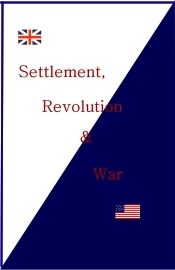
 Book #2: Settlement, Revolution & War.
Book #2: Settlement, Revolution & War.
The American Revolution1 was the first of the "wars of liberation" which increased in frequency in the 19th century and came on in great numbers during the 20th. Such conflicts usually turn into bitter civil war. Toynbee was of the view that the American Revolution was the first example we have in history of total war. "By total war we mean a war in which it is recognized that the combatants are not only the selected 'chessmen' called soldiers and sailors but the whole populations of the countries concerned?"2 Paul Johnson, in his work, A History of the American People,3 gave one contemporary guess that the colonists divided themselves into three groups: The Patriots, one third; the Tory Loyalists4, one-third; and the remainder, prepared to go along with any group who would bring back peaceful times. The neutrals, those who declined to take an active part, were likely half the population, with the other half being militants divided equally on the question. Those that supported the British Crown looked to leadership from England and were poorly served. The revolutionaries had better leaders on the ground but most were extreme in their approach to the matter as is the usual case for liberators. Street mobs will rally under any flag, if, the event gives them an excuse to smash in a shop window to get at a merchant's goods. Charles Stayner wrote, "The mob seemed willing to overlook the political sentiments of those who had nothing that could be stolen or confiscated."5 And Dr. Webster, "The chief motive on the part of the authorities seems to have been a desire to secure their property."6
So we see, that the grand thought -- that this was a war of liberation -- was not shared by all the Americans.7 The support for the revolution, however, grew as the war wore on. This was especially so after Yorktown, when, in the fall of 1781, General Cornwallis surrendered the troops under his command to Generals Washington and Rochambeau. It was to be pretty clear after that event, whether admitted or not, that the rebellious Colonies were going to win out over the distant country of Britain.
The year 1782 was marked with increasing activity in diplomatic circles to be found at London, at Lisbon, at Paris, and at Philadelphia. On the 3rd of September, 1783, the war between the colonies and Great Britain was brought to an end by treaty. Among its ten articles is to be found this one:
"That there shall be no future confiscations made nor any prosecutions commenced against any person or persons for, or by reason of, the part which he or they may have taken in the present war, and that no person shall on that account suffer any future loss or damage, either in his person, liberty, or property; and that those who may be in confinement on such charges at the time of the ratification of the treaty in America shall be immediately set at liberty, and the prosecutions so commenced be discontinued."Most of the Tories who had made themselves conspicuous as such during the war took no solace in these words. Those loyal to the British crown during the conflict felt they had no choice at the end of it, being "proscribed, despoiled and forced into exile."8 Though Toynbee attempted it, no comparison can be made to the treatment of the Quebec population by the British at the conclusion of The Seven Years War, which occurred twenty years earlier. That war was not a civil war as was the American Revolution. The French population was pretty much of the same mind in their loyalty to the British. The civil population in Canada was as least as supportive of the British administration as they had been to the French administration in earlier times.9
The Tories that took an active part on behalf of the crown during the American Revolution, at the end of it, crowded into the last two places under British control: St. Augustine and New York. New York was the principal evacuation port for the loyal Americans. Between April and November 1783, five major fleets transported as many as thirty thousand refugees to various locations in Nova Scotia.10
[NEXT: Bk. 2, Pt. 3, Ch. 2 - "Thunder and Vengeance."]
